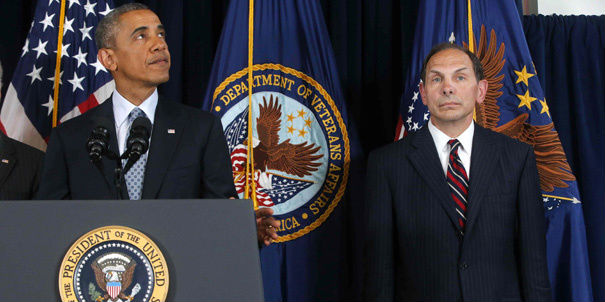President Obama on Monday with former Procter and Gamble executive Robert McDonald, his choice as new head of the Department of Veterans Affairs.
Videos by Rare
One of the debates over Obamacare was whether the law established “death panels” that would deny patients care. Defenders of the law sneered that the charge was ridiculous. And while there was no official death panel, it was easy to see how parts of it, such as the Independent Payment Advisory Board (IPAB), could easily evolve into one.
Now we know that the Department of Veterans Affairs has been functioning as one big death panel.
The Center for Investigative Reporting (CIR) says that the VA paid out $200 million to nearly 1,000 families in wrongful death cases between 2001 and 2011. And that’s only the ones where they could make a clear connection between a death and the care delivered (or lack thereof).
In addition, Senator Tom Coburn (R-Okla.), who will leave the Senate at the end of the year, has just published his own, yearlong investigative report on conditions at the VA, and he is scathing in his assessment.
Death panels can ration care in several ways. One is to simply deny patients needed care, usually justifying the denial in rational and economic grounds. For example, Great Britain’s National Health Service (NHS) is a taxpayer-funded health care system, and the government-run VA system is the closest thing we have to it. Lots of U.S. liberals look to the NHS as a model for U.S. reform.
A medical doctor associated with country’s National Institute for Health and Care Excellence (NICE), which is the country’s de facto death panel, recently explained to London’s The Sunday Times why older people should not get certain types of health care:
Do we really expect that people in their eighties with multiple insoluble health problems should have the same technology brought to bear on their cancer as those in their prime?” said Professor Karol Sikora. … My view is that age should be taken into account when comparing the potential benefits of expensive treatments. … As technology improves, we simply can’t do everything for everybody.
The fact that this death panel is referred to as NICE is not lost on anyone.
Another primary way to ration health care is to simply put people on lengthy waiting lists where many of them die. Great Britain and Canada both do that, as does the VA.
By putting patients on a waiting list, VA employees don’t have to say “you can’t be treated,” they just let patients languish there until they (1) give up and go to the private sector, (2) finally get to the head of the line, or (3) die. Note that the third option costs the government the least in most cases—unless the family of the deceased wins a wrongful death case like those mentioned earlier.
The irony—hypocrisy?—in these waiting lines is that Obamacare forces health insurers to cover a number of preventive care services with no out-of-pocket cost to the patient. The rational, which the president repeated frequently in his speeches, was that ensuring that Americans get timely preventive care would improve their quality of life and save the health care system money.
And yet the one health care system the U.S. government runs completely, and has been doing so for decades, is the worst place in the country to get timely care.
What the Coburn study and CIR reporting show is that the VA has massive quality-of-care problems, and that officials regularly put our veterans’ lives at risk.
And no one can escape the irony of our brave soldiers surviving an enemy out to kill them only to die at the hands of their government trying to save them.



